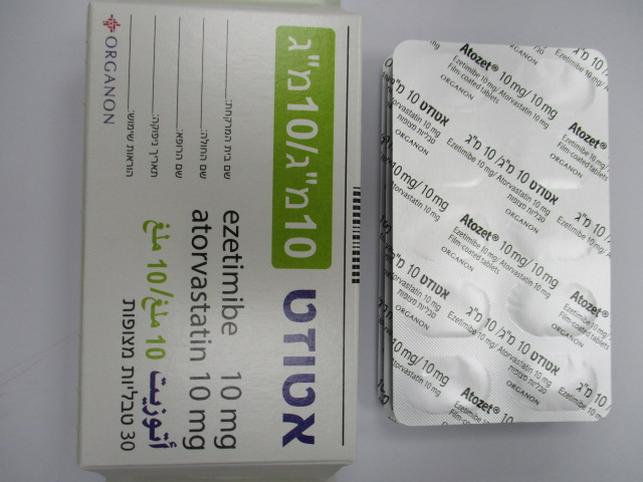Quest for the right Drug

אטוזט 10 מ"ג/10 מ"ג ATOZET10 MG/10 MG (ATORVASTATIN AS CALCIUM TRIHYDRATE, EZETIMIBE)
תרופה במרשם
תרופה בסל
נרקוטיקה
ציטוטוקסיקה
צורת מתן:
פומי : PER OS
צורת מינון:
טבליות מצופות פילם : FILM COATED TABLETS
עלון לרופא
מינוניםPosology התוויות
Indications תופעות לוואי
Adverse reactions התוויות נגד
Contraindications אינטראקציות
Interactions מינון יתר
Overdose הריון/הנקה
Pregnancy & Lactation אוכלוסיות מיוחדות
Special populations תכונות פרמקולוגיות
Pharmacological properties מידע רוקחי
Pharmaceutical particulars אזהרת שימוש
Special Warning עלון לרופא
Physicians Leaflet
Adverse reactions : תופעות לוואי
4.8 Undesirable effects Summary of the safety profile ATOZET (or co-administration of ezetimibe and atorvastatin equivalent to ATOZET) has been evaluated for safety in more than 2400 patients in 7 clinical trials. Tabulated list of adverse reactions Adverse reactions observed in clinical studies of ATOZET (or co-administration of ezetimibe and atorvastatin equivalent to ATOZET) or ezetimibe or atorvastatin or reported from post-marketing use with ATOZET or ezetimibe or atorvastatin are listed in Table 3. These reactions are presented by system organ class and by frequency. Frequencies are defined as: very common (≥1/10); common ≥1/100, <1/10); uncommon (≥1/1000, <1/100); rare (≥1/10,000, <1/1000); very rare (<1/10,000); and not known (cannot be estimated from the available data). Table 3 Adverse Reactions System organ class Adverse reaction Frequency Infections and infestations Uncommon influenza Not known nasopharyngitis Blood and lymphatic system disorders Not known thrombocytopenia Immune system disorders Not known hypersensitivity, including anaphylaxis, angioedema, rash, and urticaria Metabolism and nutrition disorders Not known decreased appetite; anorexia; hyperglycaemia; hypoglycaemia Psychiatric disorders Uncommon depression; insomnia; sleep disorder Not known nightmares Nervous system disorders Uncommon dizziness; dysgeusia; headache; paraesthesia Not known hypoesthesia; amnesia; peripheral neuropathy Eye disorders Not known vision blurred; visual disturbance Ear and labyrinth disorders Not known tinnitus; hearing loss Cardiac disorders Uncommon sinus bradycardia Vascular disorders Uncommon hot flush Not known hypertension Respiratory, thoracic and mediastinal disorders Uncommon dyspnoea Not known cough; pharyngolaryngeal pain; epistaxis Gastrointestinal disorders Common diarrhoea Uncommon abdominal discomfort; abdominal distension; abdominal pain; abdominal pain lower; abdominal pain upper; constipation; dyspepsia; flatulence; frequent bowel movements; gastritis; nausea; stomach discomfort Not known pancreatitis; gastro-oesophageal reflux disease; eructation; vomiting; dry mouth Hepatobiliary disorders Not known hepatitis; cholelithiasis; cholecystitis; cholestasis; fatal and non-fatal hepatic failure Skin and subcutaneous tissue disorders Uncommon acne; urticaria Not known alopecia; skin rash; pruritus; erythema multiforme; angioneurotic oedema; dermatitis bullous including erythema multiforme, Stevens-Johnson syndrome and toxic epidermal necrolysis Musculoskeletal and connective tissue disorders Common myalgia Uncommon arthralgia; back pain; muscle fatigue; muscle spasms; muscular weakness; pain in extremity Not known myopathy/rhabdomyolysis; muscle rupture; tendinopathy, sometimes complicated by rupture; neck pain; joint swelling; myositis; lupus-like syndrome; immune-mediated necrotizing myopathy (see section 4.4) Reproductive system and breast disorders Not known gynaecomastia General disorders and administration site conditions Uncommon asthenia; fatigue; malaise; oedema Not known chest pain; pain; peripheral oedema; pyrexia Investigations Uncommon ALT and/or AST increased; alkaline phosphatase increased; blood creatine phosphokinase (CPK) increased; gamma-glutamyltransferase increased; hepatic enzyme increased; liver function test abnormal; weight increased Not known white blood cells urine positive Laboratory Values In controlled clinical trials, the incidence of clinically important elevations in serum transaminases (ALT and/or AST ≥3 X ULN, consecutive) was 0.6% for patients treated with ATOZET. These elevations were generally asymptomatic, not associated with cholestasis, and returned to baseline spontaneously or after discontinuation of therapy (see section 4.4). The following adverse events have been reported with some statins: • sexual dysfunction • exceptional cases of interstitial lung disease, especially with long term therapy (see section 4.4) • diabetes mellitus: frequency will depend on the presence or absence of risk factors (fasting blood glucose ≥ 5.6 mmol/L, BMI> 30 kg/m2, raised triglycerides, history of hypertension) Reporting of suspected adverse reactions Reporting suspected adverse reactions after authorisation of the medicinal product is important. It allows continued monitoring of the benefit/risk balance of the medicinal product. Any suspected adverse events should be reported to the Ministry of Health according to the National Regulation by using an online form /https://sideeffects.health.gov.il

שימוש לפי פנקס קופ''ח כללית 1994
לא צוין
תאריך הכללה מקורי בסל
לא צוין
הגבלות
לא צוין
מידע נוסף
עלון מידע לצרכן
08.03.18 - עלון לצרכן 11.01.21 - עלון לצרכן אנגלית 11.01.21 - עלון לצרכן עברית 08.03.18 - עלון לצרכן ערבית 24.01.21 - עלון לצרכן ערבית 15.11.22 - עלון לצרכן אנגלית 15.11.22 - עלון לצרכן עברית 15.11.22 - עלון לצרכן ערבית 26.04.20 - החמרה לעלון 11.01.21 - החמרה לעלון 15.11.22 - החמרה לעלוןלתרופה במאגר משרד הבריאות
אטוזט 10 מ"ג/10 מ"ג